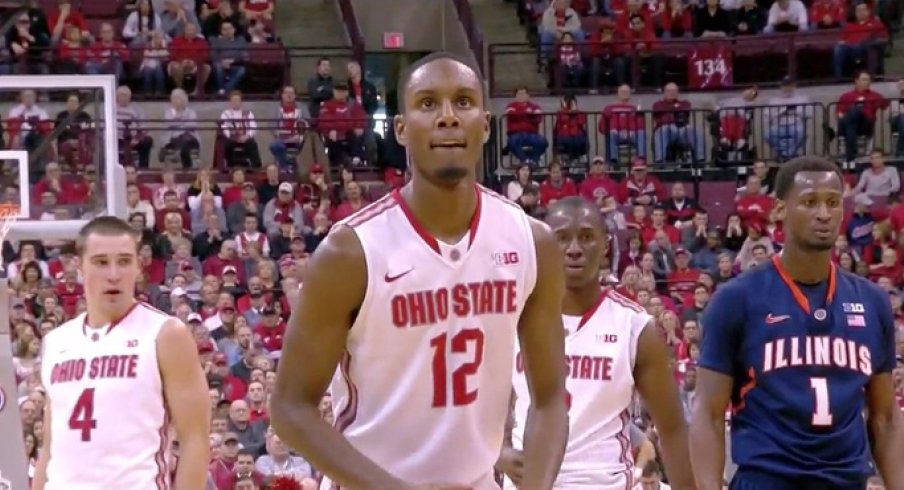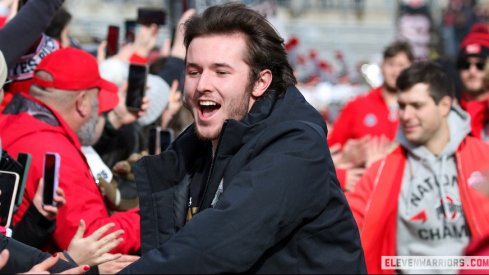The 2013-14 season ended much too soon. Although this year’s version of the basketball Buckeyes was a very flawed one, Thad Matta led his club to 25 victories and finished in the upper half of the rugged Big Ten.
The B1G may not be as strong at the top as it was a year ago, but the bottom half made giant strides over the course of the year, making automatic wins a thing of the past.
Along the way, there were frustrating losses, ugly wins, and, yes, several moments of the kind of magic Matta’s squad has become known over the years.
Any team is made up of individuals who must jell together to be successful. Herein we’ll look at the individuals who made up this year’s Ohio State hoops team and grade their performance overall. In so doing, it’s important to fight through the frustration and try to give an honest assessment. This is my attempt, beginning with the starters and continuing through all nine guys in the regular rotation.
Aaron Craft
It’s easy to point at Craft and blame him for some of the team’s issues. His scoring average dropped slightly (from 10.0 to 9.8 PPG), he set a career high in turnovers (90), and he made a career low in three-pointers (16).
On the other hand, Craft tried to step up and be a leader on offense in the wake of losing DeShaun Thomas, and that simply isn’t who he is. I suspect that’s what the coaches asked of him and to his credit he did his best. Meanwhile, he actually raised his field goal percentage and 3FG% from last year.
His offensive numbers never sparkled over his career, but they remained remarkably consistent. Meanwhile, he posted the most steals since his sophomore year, established a new high in rebound average and put up comparable assist numbers despite playing in the fewest games of his career on a team that couldn’t hit its open jump shots.
He finishes his career as the school’s leader in steals and assists — ranking first and fifth all-time in conference history in those categories, respectively — and is among the top 30 scorers in OSU history. You can take points off for Craft trying to do too much at times, but bear in mind that he was probably asked to do so by the staff.
Grade: A-
Lenzelle Smith Jr.
Smith is a player that many fans find frustrating. Indeed, he seemed capable of becoming a David Lighty type, but never quite reached Lighty-esque levels over his career. Always a streaky shooter, Smith became a lightning rod for fans whenever his shots weren’t falling and the team was struggling.
However, Smith increased his scoring average to a career-high 11.0, and hit 50 triples, also a career mark. He bettered his free throw percentage from .687 to .755 and got to the line a career high 102 times. Until his last 11 games, Smith was on pace for a career best in long-range shooting percentage and was scoring about 13 points per game.
He raised his rebounding average to a new high of 5.06, turned the ball over less often than ever, and was only one assist off last year despite playing two fewer games and having the bricklayer’s union for a team.
Perhaps the most frustrating stretch of Smith’s career consisted of his last seven games, during which he scored in double figures only once — 19 in a loss at Indiana. Undoubtedly, hitting only six of his final 34 attempts from distance (17.6%) will stick in people’s minds, but Smith still had a better year than most will credit him with, when you consider it against his previous three seasons.
Grade: B-
Sam Thompson
While Smith had a better season historically than many will remember, it’s surprising that Thompson’s numbers actually dropped somewhat. It seemed like he became a three-point threat and stepped up his defense in 2013-14, but the numbers don’t support that.
While Slam did hit four more triples than last year, his 3FG% dropped from .404 to .355 and his overall field goal percentage dipped from .498 to .450. Even his free throw percentage was lower this season (from .703 to .618). His rebounding average fell from 3.51 to 2.71 too.
Thompson has a world of potential and he’s a likable guy, but he scored only a tenth of a point per game more than last season. Still, he’s getting better as a defender and shot blocker and I’m no longer quite so terrified when he attempts a three.
Grade: C+
LaQuinton Ross
Ross became a first-year starter in 2013-14 and was counted on to replace the offense lost when Thomas turned pro. That may not be fair, but Ross mostly stepped up. His shooting percentage on twos and threes dipped slightly, but that’s to be expected when going from 17 to 29 minutes per game.
The junior from Jackson, Miss., nearly doubled his scoring average, going from 8.3 points per game to 15.2. His free throw percentage also dropped very slightly, but he got to the line much more often.
Like Smith, Ross’s three-point shooting abandoned him down the stretch. In his last eight games this season, Ross hit only two of 21 from distance (9.5%) and was only 1/14 from the arc in postseason.
Defensively, Ross improved but his inside help game still needs work. His steals, assists and blocks were all areas of improvement.
Grade: B
Amir Williams
Perhaps no one has done less with more than the former McDonald’s All-American from Detroit. You’ve seen the lost balls in traffic, the perfectly placed passes that slide right from between the two frying pans he calls hands, and the lack of finishing around the rim.
But to say that Williams didn’t improve during his junior year would be a lie.
It may be fair to say that we all expected more from Williams at this point in his career. But you can’t dismiss the progress he’s made.
Williams improved his scoring average from 3.5 to 7.8 points per game. He averaged 16.5 minutes as a sophomore and increased that to 23 in 2013-14. His rebounding average rose from 3.9 to 5.8 per game. He blocked 12 more shots and stole two more balls this season in two fewer games (albeit, playing more minutes) and more than doubled his assist total.
Last year, Williams made about half his free throws. This year he got to the line more often and put more of those freebies away (.651). And he turned in three double-doubles.
If he can turn in as big of an improvement next season as he did this year, we may remember Williams in a whole different light. But he’ll have to avoid the seemingly disinterested performances and have more discipline on defense.
Grade: C
Shannon Scott
Scott’s year speaks of offensive inconsistency. The junior from Georgia increased his minutes per game by six in 2013-14 and made his first 21 career starts, averaging 7.5 points (up from 4.9 last year). He increased his overall shooting percentage from .408 to .432 and his free throw average from .627 to .683.
However, Scott’s long-range percentage dipped from .333 to .302, he tallied 23 fewer assists and turned the ball over 20 more times than last year. On the defensive end, he did set a career high with 71 steals, but he also blocked only five shots, compared to 11 a year ago. He pulled down about half a rebound more per game this season.
He showed flashes of what he could do against Morgan State, Purdue and especially in the B1G semifinals against Michigan. Maybe he’ll be able to crawl out from under Craft’s shadow next season and find the offensive consistency to become a complete player.
Grade: C+
Trey McDonald
Probably the largest indictment of McDonald as a player is that even with the performances that Williams turned in, Trey could only find the floor 12 minutes per game — a five-minute increase over last year.
But even with those extra minutes, his scoring and rebounding averages remained about the same while his field goal percentage dipped slightly. And he makes only a third of his free throws.
The positives: he sometimes brought some energy to the floor; his blocks exploded from four total over his first two years to 19 this season; and he made seven steals compared to two for his career prior to this year — all while playing out of position at the five.
Still, there was no real progression in his game, he turned the ball over too often, and he just simply doesn’t seem to be the caliber of player a major program requires.
Grade: F
Amedeo Della Valle
As a sophomore, Della Valle showed some flashes of what he can bring to the table when he’s on his game. This was never more apparent than his performance against Nebraska in the Big Ten tournament. He provided energy, an offensive spark and solid defense en route to 12 points, six boards, three blocks and two steals in just 21 minutes to lead Ohio State’s comeback.
If only there had been more of that.
The floppy haired Italian improved from 2.5 points per game to 4.0 in year two, playing about four more minutes (11.9) per game. His overall and distance shooting dipped, as he often rushed his play to try to make an impact in his limited minutes.
Aside from games played (from 15 to 33), none of his numbers significantly improved, aside from his turnovers and personal fouls increasing.
Had he not decided yesterday to move back to Europe to play professionally, ADV had a chance to improve and take over Craft's place as most hated Buckeye by opposing fans. Alas, we'll never know how his career could have gone. And that makes me sad.
Grade: D
Marc Loving
As the lone active freshman on the team, Loving showed a ton of potential and promise. His 4.4 points per game average isn’t gaudy, and he made only 25.9% of his triples but he appeared in all 35 games and Matta seemed to trust him more than almost anyone else on his bench.
The most important aspect was that the game didn’t seem too big for him. He appears to be a coachable kid who will learn Matta’s defensive requirements and his offensive game will come with more experience. He’s the most impressive Ohio State freshman since Sullinger/Craft/Thomas.
I’ll grade him on a curve for being a freshman.
Grade: C-


